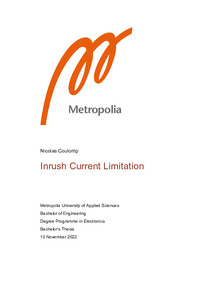Inrush Current Limitation
Coulomp, Nicolas (2022)
Coulomp, Nicolas
2022
All rights reserved. This publication is copyrighted. You may download, display and print it for Your own personal use. Commercial use is prohibited.
Julkaisun pysyvä osoite on
https://urn.fi/URN:NBN:fi:amk-2022112423945
https://urn.fi/URN:NBN:fi:amk-2022112423945
Tiivistelmä
This thesis work was carried out for Nexess, a French company specialized in asset tracking using RFID technology and smart cabinets. The project went through the process of designing an inrush current limiter prototype, in order to add this functionality to one of the company’s products, the XL cabinet, which was developed by the company to make real time inventories of different kind of tools and assets.
The limiter device was intended to be implemented in the Nexess’ XL hardware line and to have the ability to be adaptable into the existing hardware.
Ultimately, the limiter will allow their customers to connect more equipment at the same time and more safely to the 230V sockets inside the equipment.
This thesis was divided into four parts. In the first part, the project focused on bibliographic research and described the different inrush current limiting topologies available on the market. The second part involved inrush current measurements and search for correlation between inrush current and the phase of the signal, this included the realization of a phase control circuit as well as the simulation of the circuit.
The third part concentrated on defining the limits of the system and testing the first prototype previously developed by Nexess.
The last part of this thesis work contained confidential informations which were exclusive to Nexess, thus for privacy reasons it was not allowed to publish all the content of this part. It was focused on the realisation of a new version of the inrush current limiter prototype. Simulations of the different circuits were done in Simetrix and LT Spice software, and the schematics and PCB layout were completed in Altium designer.
As result, this project was a success, and the company expects to introduce the inrush current limiter into Nexess’ line of equipment after following qualifications.
The limiter device was intended to be implemented in the Nexess’ XL hardware line and to have the ability to be adaptable into the existing hardware.
Ultimately, the limiter will allow their customers to connect more equipment at the same time and more safely to the 230V sockets inside the equipment.
This thesis was divided into four parts. In the first part, the project focused on bibliographic research and described the different inrush current limiting topologies available on the market. The second part involved inrush current measurements and search for correlation between inrush current and the phase of the signal, this included the realization of a phase control circuit as well as the simulation of the circuit.
The third part concentrated on defining the limits of the system and testing the first prototype previously developed by Nexess.
The last part of this thesis work contained confidential informations which were exclusive to Nexess, thus for privacy reasons it was not allowed to publish all the content of this part. It was focused on the realisation of a new version of the inrush current limiter prototype. Simulations of the different circuits were done in Simetrix and LT Spice software, and the schematics and PCB layout were completed in Altium designer.
As result, this project was a success, and the company expects to introduce the inrush current limiter into Nexess’ line of equipment after following qualifications.
